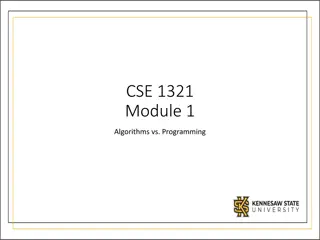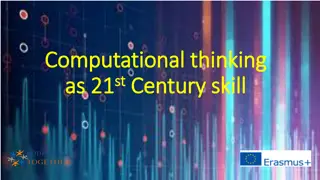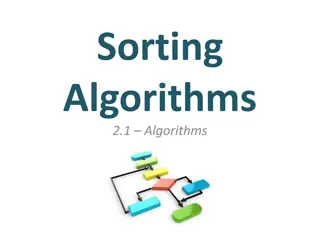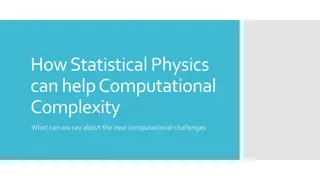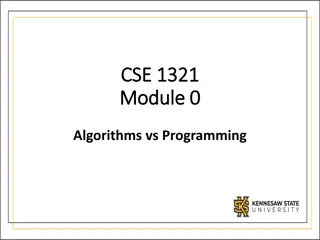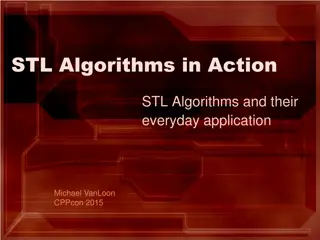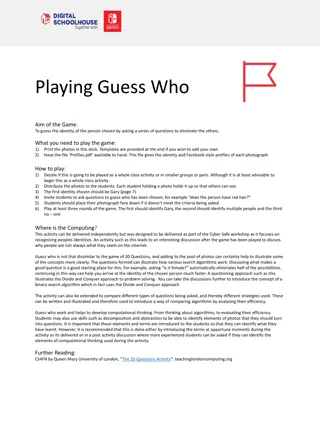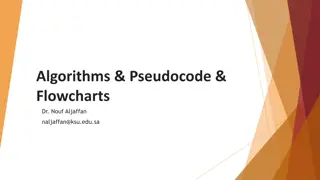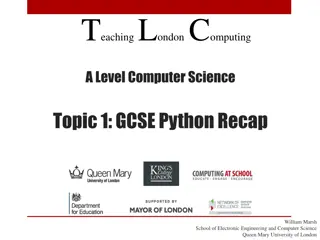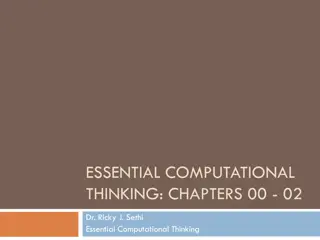Computational Thinking, Algorithms & Programming Overview
This unit covers key concepts in computational thinking, including decomposition, abstraction, and algorithmic thinking. Decomposition involves breaking down complex problems, abstraction focuses on identifying essential elements, and algorithmic thinking is about defining clear instructions to solve problems. Through examples like creating a snakes and ladders game, students will learn how to apply these concepts in computer programming.
Download Presentation

Please find below an Image/Link to download the presentation.
The content on the website is provided AS IS for your information and personal use only. It may not be sold, licensed, or shared on other websites without obtaining consent from the author.If you encounter any issues during the download, it is possible that the publisher has removed the file from their server.
You are allowed to download the files provided on this website for personal or commercial use, subject to the condition that they are used lawfully. All files are the property of their respective owners.
The content on the website is provided AS IS for your information and personal use only. It may not be sold, licensed, or shared on other websites without obtaining consent from the author.
E N D
Presentation Transcript
Unit 2: Computational Thinking, Algorithms & Programming Computational Thinking 2.1 - Algorithms
Thursday, 08 August 2024 Computational Thinking Unit 2: Computational Thinking, Algorithms & Programming Learning Objective: To be able to demonstrate an understanding of the thought processes involved in understanding problems and formulating solutions that computers can process. Success Criteria: 1. I can define the terms Decomposition, Abstraction and Algorithmic Thinking. 2. I can explain how each of these are used to help understand and process computing problems.
Unit 2: Computational Thinking, Algorithms & Programming Decomposition Decomposition reduces a problem into sub-problems or components. These smaller parts are easier to understand and solve. Problem Create a snakes and ladders computer game Definition: Breaking a complex problem down into smaller problems and solving each one individually. Sub-problems As you can see in this example, the main problem has been decomposed into smaller sub- problems making it easier to understand. Design of playing area Example: Positions of snakes and ladders Dice throw for each player Movement of each player on the board Just like how you used decomposition to break down your NEA task. Movement up ladders and down snakes How does a player finish?
Definition: the process of removing unnecessary details so that only the main, important points remain. Unit 2: Computational Thinking, Algorithms & Programming Abstraction Abstraction identifies essential elements that must be included in the computer models of real- life situations and discards inessential ones. Example: For a computer model of Snakes and Ladders , the sub- problem Dice throw for each player includes the essential element Generate a random number between 1 and 6 . When driving a car, there are some essential elements that you need to know: How to turn on the engine How to use the brakes How to use the gears There are some inessential elements that you could afford to ignore: The number of miles per gallon The dimensions of the wheels How each component under the bonnet works These inessential things are useful to know, but not essential to actually driving the car = Abstraction. Inessential elements would include whether you use a shaker, how long you shake it for and how far you throw the dice.
Unit 2: Computational Thinking, Algorithms & Programming Algorithmic Thinking Algorithmic thinking is a subset of computational thinking that involves defining a clear set of instructions to solve a problem. Once a successful solution to a problem has been found, it can be used repeatedly for the same problem. For example, the process of calculating the mean of a set of numbers is always the same irrespective of how many numbers and what they are add up all the numbers and divide the total by the number in the set. Definition: a logical way of getting from the problem to the solution. A set of instructions for solving a problem.


